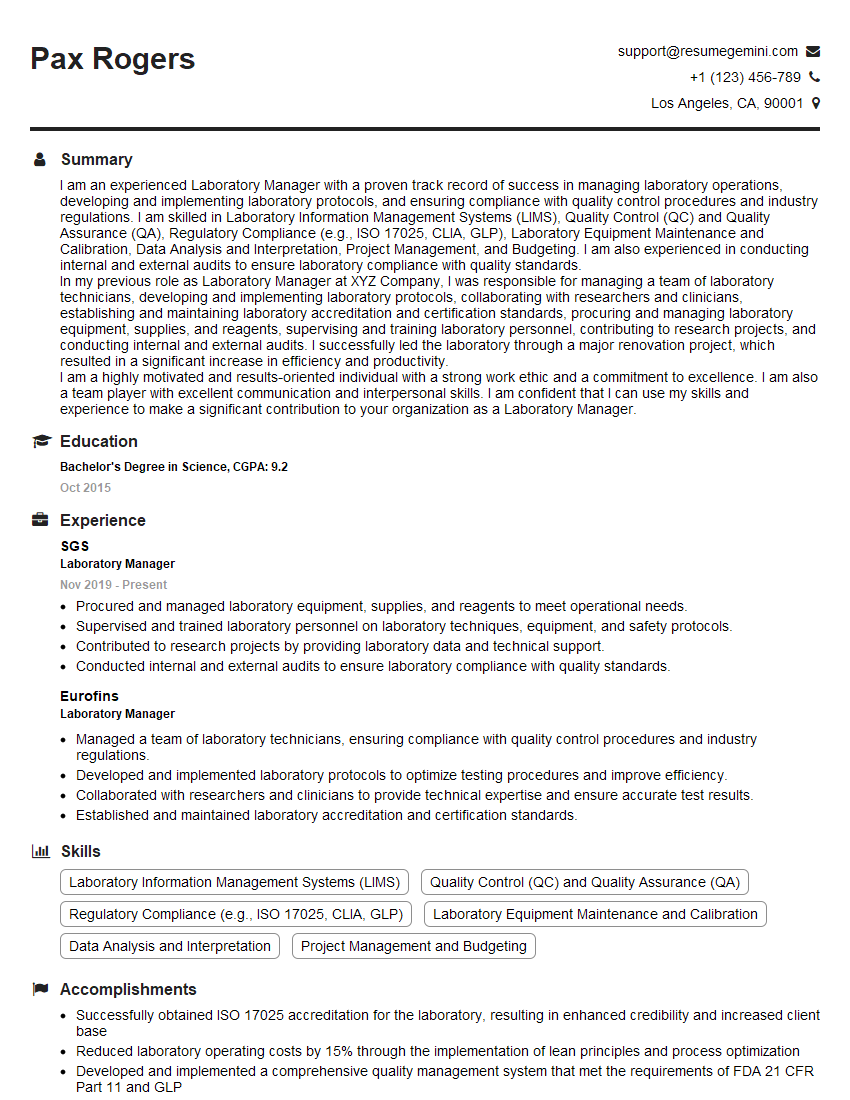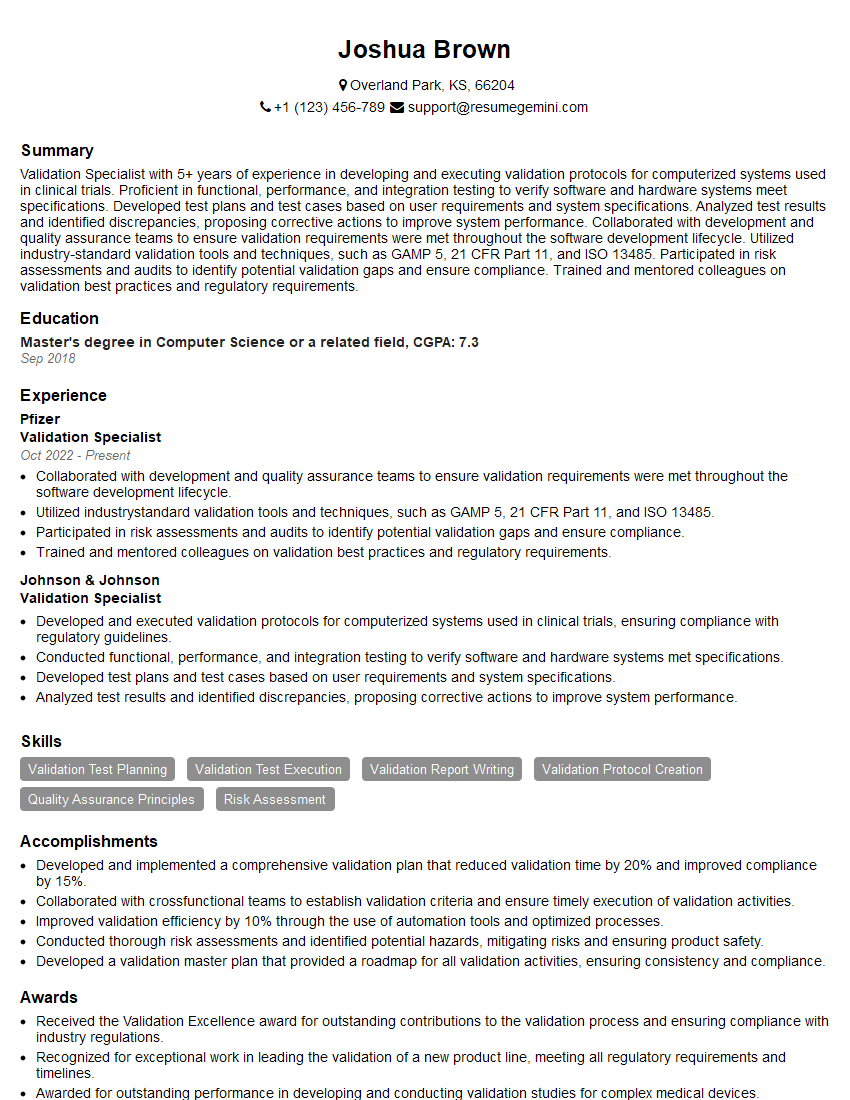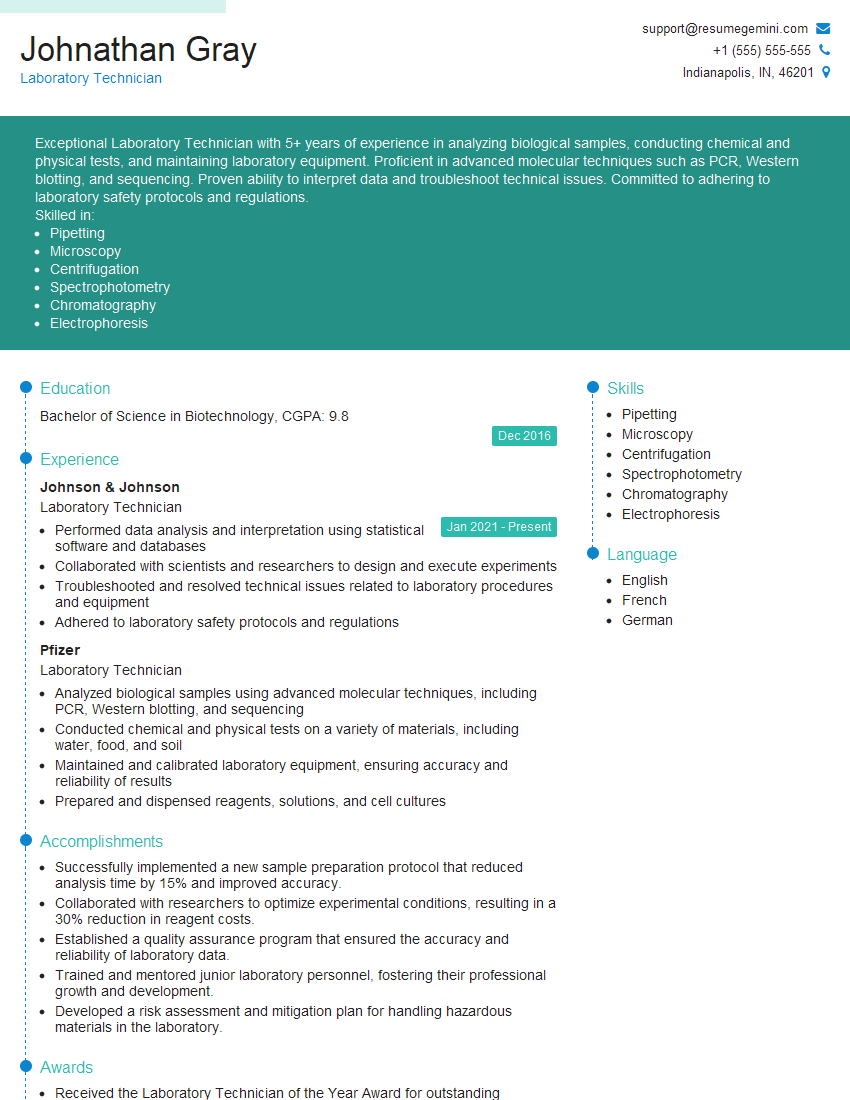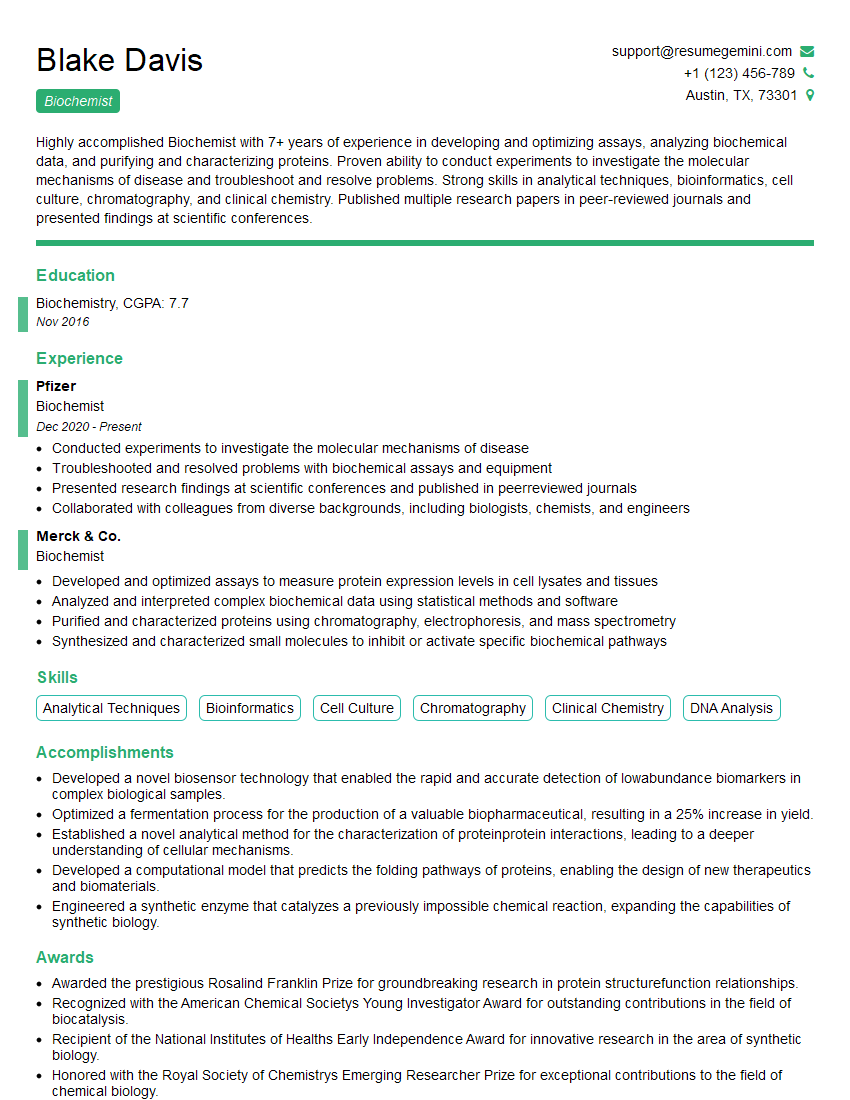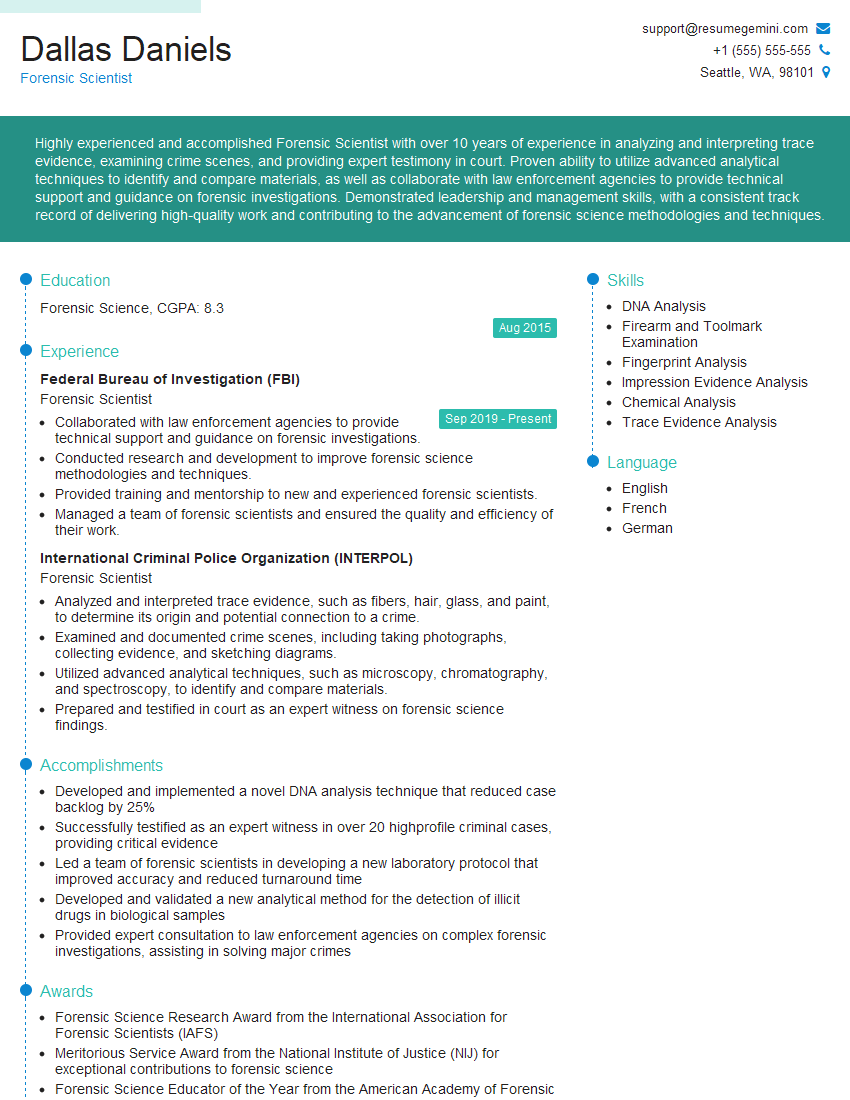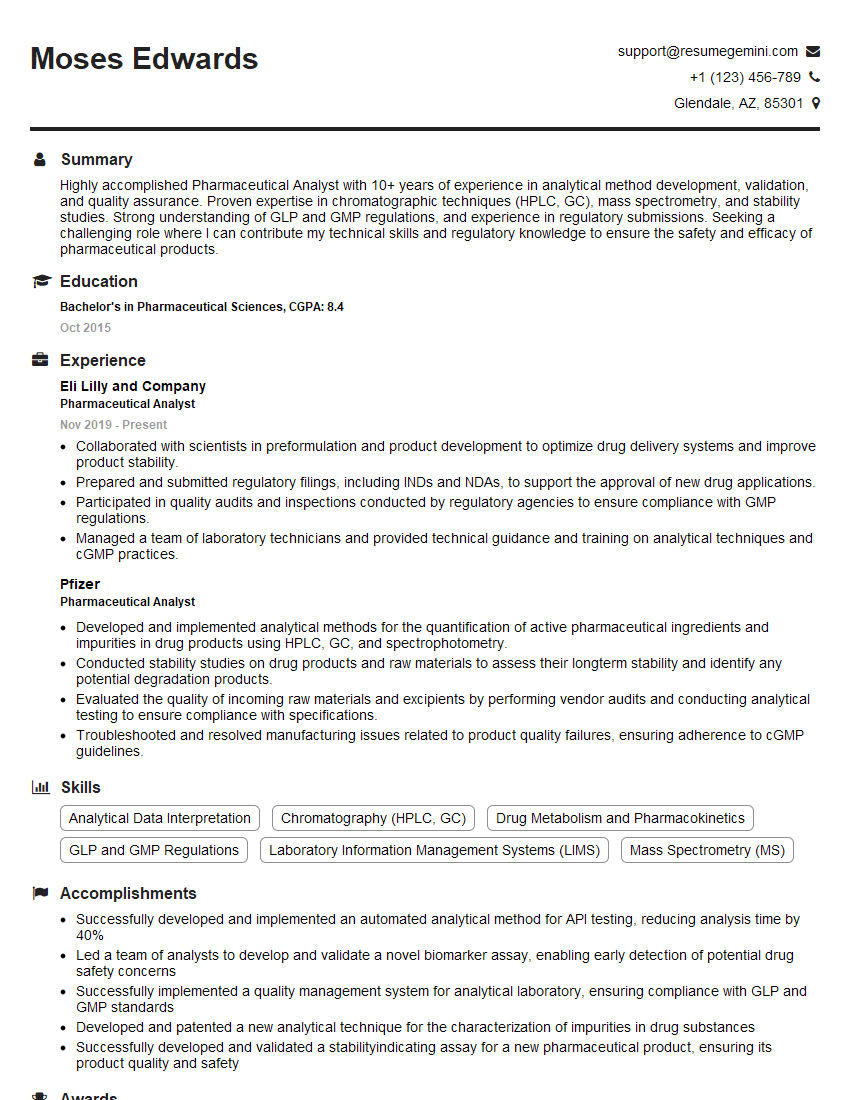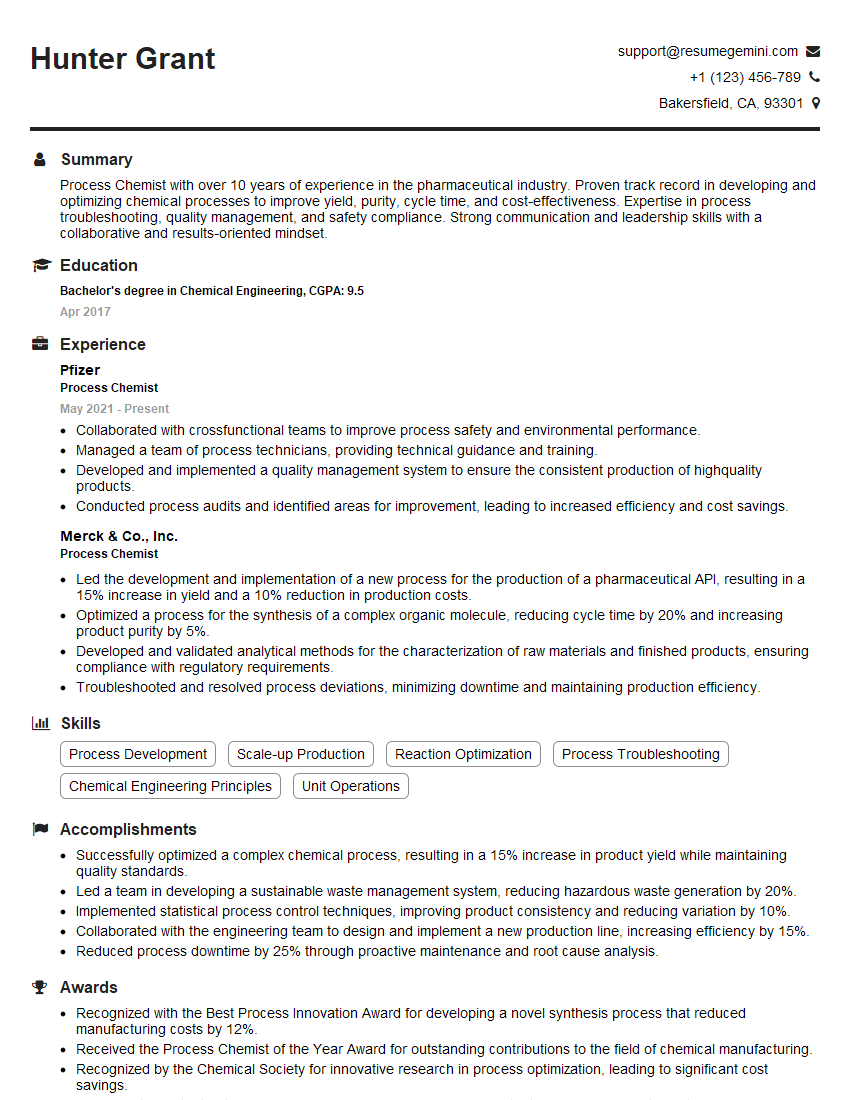Unlock your full potential by mastering the most common UV-Vis Analysis interview questions. This blog offers a deep dive into the critical topics, ensuring you’re not only prepared to answer but to excel. With these insights, you’ll approach your interview with clarity and confidence.
Questions Asked in UV-Vis Analysis Interview
Q 1. Explain the Beer-Lambert Law and its limitations.
The Beer-Lambert Law, also known as the Beer-Lambert-Bouguer law, is the fundamental principle behind UV-Vis spectroscopy. It states that the absorbance of a solution is directly proportional to the concentration of the analyte and the path length of the light through the solution. Mathematically, it’s represented as A = εbc, where A is the absorbance, ε is the molar absorptivity (a constant specific to the analyte and wavelength), b is the path length of the light through the sample (usually 1 cm), and c is the concentration of the analyte.
However, this law has limitations. It’s only accurate under specific conditions. These limitations include:
- Deviations at high concentrations: At high concentrations, analyte molecules interact with each other, affecting their absorption properties and leading to deviations from linearity.
- Chemical changes: If the analyte undergoes chemical reactions or changes its structure in the solution, the absorbance will not accurately reflect the initial concentration.
- Scattering effects: Turbid or cloudy samples can scatter light, leading to inaccurate absorbance readings. This is especially relevant for solutions with suspended particles.
- Stray light: Light of wavelengths outside the intended wavelength range reaching the detector can also affect the accuracy of the measurements. This is less common with modern instruments.
- Non-monochromatic light source: The law assumes a monochromatic light source (light of a single wavelength). Real-world sources are not perfectly monochromatic, leading to minor errors.
Imagine trying to measure the shadow cast by a single object. The Beer-Lambert Law is like saying the shadow’s darkness is directly proportional to the object’s size and the distance the light travels. But if you have many objects overlapping, or if the object itself changes shape, that simple relationship breaks down.
Q 2. Describe the different types of UV-Vis spectrophotometers.
UV-Vis spectrophotometers come in various types, primarily categorized by their design and the way they handle the light source and sample. Some key types include:
- Single-beam spectrophotometers: These are simpler and more affordable instruments. They measure the intensity of light passing through the sample and then measure the intensity of light passing through a blank (solvent only) separately. The ratio is used to calculate the absorbance.
- Double-beam spectrophotometers: These are more sophisticated and offer better accuracy. They split the light beam into two – one path goes through the sample, and the other through a reference (blank). This simultaneous measurement compensates for fluctuations in the light source and improves precision.
- Diode array spectrophotometers: These measure the entire spectrum of light simultaneously, providing a rapid acquisition of spectral data. This is advantageous when dealing with time-dependent processes or transient species.
- Scanning spectrophotometers: These instruments use a monochromator to select a specific wavelength of light, which is then passed through the sample. The wavelength is scanned across the desired range to build the spectrum.
The choice depends on the application; a single-beam instrument might suffice for routine analysis, whereas a diode array is ideal for kinetic studies or when high speed is crucial.
Q 3. What are the common applications of UV-Vis spectroscopy?
UV-Vis spectroscopy boasts a wide array of applications across various scientific disciplines. Some common applications include:
- Quantitative analysis: Determining the concentration of a substance in a solution using the Beer-Lambert Law. This is extensively used in environmental monitoring, pharmaceutical analysis, and clinical chemistry.
- Qualitative analysis: Identifying a substance based on its characteristic absorption spectrum (a ‘fingerprint’ of the molecule). This helps in identifying unknown compounds or verifying the purity of a known substance.
- Kinetic studies: Monitoring the rate of a chemical reaction by observing the change in absorbance over time. This can be useful in studying reaction mechanisms and determining rate constants.
- Equilibrium studies: Determining equilibrium constants by measuring absorbance at equilibrium conditions.
- Protein analysis: Measuring the concentration and purity of proteins and analyzing their secondary structure.
- Environmental monitoring: Detecting and quantifying pollutants in water, air, and soil.
For instance, in a pharmaceutical lab, UV-Vis might be used to check the purity of a drug or to ensure the concentration meets specifications during production. In environmental monitoring, it can be used to measure the levels of nitrates in drinking water.
Q 4. How do you prepare samples for UV-Vis analysis?
Sample preparation is critical for accurate UV-Vis analysis. The key goal is to create a homogeneous, clear solution with minimal scattering that allows for the accurate measurement of light absorbance. The specific preparation depends on the analyte and the solvent. General steps include:
- Choosing the right solvent: The solvent should dissolve the analyte completely and not absorb significantly in the UV-Vis range of interest. Common solvents include water, methanol, ethanol, and acetonitrile.
- Preparing the solution: Accurately weigh or measure the analyte and dissolve it in the chosen solvent to achieve the desired concentration. Ensure the solution is thoroughly mixed.
- Filtering the solution: Removing any particulate matter or dust from the solution helps to minimize light scattering. A syringe filter is often used for this purpose.
- Preparing blanks: A blank is a solution containing the solvent only. It is used to calibrate the spectrophotometer and to correct for any absorbance of the solvent itself.
- Using appropriate cuvettes: These are the small, transparent containers that hold the sample. They must be clean and free of scratches or imperfections.
For example, if measuring the concentration of a colored dye, it would be dissolved in a suitable solvent like water or methanol to make a clear solution before being measured in a cuvette.
Q 5. Explain the concept of molar absorptivity.
Molar absorptivity (ε), also known as the molar extinction coefficient, is a constant that represents how strongly a substance absorbs light at a particular wavelength. It’s a measure of the analyte’s intrinsic ability to absorb light, and it’s specific to both the analyte and the wavelength of light. The higher the molar absorptivity, the stronger the absorption for a given concentration and path length.
In the Beer-Lambert Law (A = εbc), ε represents the molar absorptivity. It has units of L mol-1 cm-1. It’s often determined experimentally by measuring the absorbance of a solution of known concentration and path length, then solving for ε.
Think of it as a ‘light-absorbing power’ of a specific molecule at a specific wavelength. A molecule with high molar absorptivity will absorb more light at that wavelength compared to a molecule with low molar absorptivity, given the same concentration and path length.
Q 6. How do you determine the concentration of an unknown sample using UV-Vis spectroscopy?
To determine the concentration of an unknown sample using UV-Vis spectroscopy, you typically follow these steps:
- Prepare a calibration curve: Measure the absorbance of several solutions of the analyte with known concentrations. Plot the absorbance (A) against the concentration (c). This should give you a linear relationship (following the Beer-Lambert Law).
- Measure the absorbance of the unknown sample: Use the same conditions (wavelength, path length, solvent) as the calibration curve.
- Determine the concentration from the calibration curve: Locate the measured absorbance on the y-axis of the calibration curve and find the corresponding concentration on the x-axis.
- Alternatively, use the Beer-Lambert Law: If you know the molar absorptivity (ε) of the analyte at the chosen wavelength, you can use the Beer-Lambert equation (A = εbc) to calculate the concentration directly. Solve for ‘c’ after measuring ‘A’.
It’s essential to ensure the unknown sample is prepared and measured under the same conditions as the calibration curve. This minimizes errors and ensures accurate results.
Q 7. What are the factors that can affect the accuracy of UV-Vis measurements?
Several factors can influence the accuracy of UV-Vis measurements. These include:
- Stray light: Unwanted light reaching the detector outside of the desired wavelength can cause deviations from the Beer-Lambert Law.
- Solvent absorption: The solvent itself might absorb light at the wavelengths of interest, leading to inaccurate measurements. Choosing a suitable solvent that’s transparent at the wavelengths used is crucial.
- Scattering: Cloudy or turbid samples can scatter light, leading to artificially high absorbance readings.
- Cuvette cleanliness and quality: Scratches or fingerprints on the cuvette can affect the light path, causing errors. Using clean, matched cuvettes (identical optical path length) is vital.
- Instrument calibration: Proper calibration of the spectrophotometer is crucial. This involves using a blank solution (solvent only) to zero the instrument and ensure accurate baseline readings.
- Temperature variations: Temperature can affect absorbance, particularly in reactions with significant temperature dependence. Controlling the temperature during measurement is important for some analyses.
- Concentration range: The Beer-Lambert law only holds true for a specific concentration range. Deviations can occur at high concentrations due to intermolecular interactions.
Careful attention to these factors is essential for obtaining accurate and reliable UV-Vis spectroscopy data.
Q 8. How do you perform a blank correction in UV-Vis spectroscopy?
Blank correction in UV-Vis spectroscopy is crucial for eliminating the absorbance contribution from the solvent and cuvette, ensuring that only the analyte’s absorbance is measured. Think of it like zeroing out a scale before weighing an ingredient – you want to measure only the ingredient, not the weight of the container.
The process involves measuring the absorbance of a blank sample, which contains everything except the analyte (e.g., the solvent in the same cuvette). This blank absorbance reading is then subtracted from all subsequent sample readings. Most spectrophotometers have an automated blank correction feature. To perform it manually, you’d first measure the blank’s absorbance at each wavelength. Then, for each sample, subtract the corresponding blank absorbance at each wavelength from the sample’s absorbance at that same wavelength. For example, if your blank’s absorbance at 250 nm is 0.1 and your sample’s absorbance at 250 nm is 0.8, the corrected absorbance is 0.7 (0.8 – 0.1).
Q 9. Explain the difference between absorbance and transmittance.
Absorbance and transmittance are two ways of expressing the interaction of light with a sample in UV-Vis spectroscopy. They are inversely related. Transmittance (T) is the fraction of light that passes through the sample, expressed as a percentage or a decimal. Absorbance (A), on the other hand, represents the amount of light absorbed by the sample.
Imagine shining a flashlight through a colored liquid. Transmittance tells us what fraction of light makes it through to the other side; a high transmittance means most light passed through (a very light or transparent solution), while a low transmittance indicates that much of the light was absorbed (a dark solution). Absorbance is directly proportional to the concentration of the analyte (Beer-Lambert Law) and represents how much light was absorbed, allowing for quantitative analysis.
The mathematical relationship is given by: A = -log10T
Q 10. What is the significance of the wavelength maximum (λmax)?
The wavelength maximum (λmax) is the wavelength at which a substance absorbs light most strongly. It’s a characteristic property of a molecule and is crucial for identification and quantification. Each molecule has a unique absorption spectrum with specific λmax values. Think of it like a fingerprint – it helps us identify the molecule.
The λmax is essential for several reasons:
- Qualitative Analysis: It aids in identifying unknown compounds by comparing their spectra with known spectral databases.
- Quantitative Analysis: Measurements at λmax provide the highest sensitivity in quantitative analysis, because the change in absorbance is greatest around the λmax, giving us the most accurate results from the Beer-Lambert law.
- Optimizing Measurements: Knowing the λmax allows us to choose the optimal wavelength for quantitative analysis, maximizing the signal and minimizing errors.
Q 11. How do you troubleshoot a UV-Vis spectrophotometer?
Troubleshooting a UV-Vis spectrophotometer requires a systematic approach. Here’s a step-by-step guide:
- Check the instrument’s baseline: A blank scan should ideally give a flat line near zero absorbance across the entire wavelength range. If not, the instrument might need warming up or cleaning. Stray light is a possible cause of a non-flat baseline.
- Inspect the cuvettes: Ensure the cuvettes are clean and free from scratches or fingerprints. Fingerprints significantly impact absorbance readings. Always use matched cuvettes (same material, dimensions and optical quality) to ensure accurate comparisons.
- Verify the wavelength calibration: Use a known standard with a sharp absorption peak at a specific wavelength (e.g., Holmium oxide filter or other certified standards) to verify if the instrument is accurately reporting wavelengths.
- Check the lamp: If the light source (Deuterium or Tungsten lamp) is failing, you may see a decrease in intensity or unusual noise in the spectrum. Consult the instrument’s manual for lamp replacement procedures.
- Examine the detector: If the instrument displays noisy readings or inconsistent results, the detector may be faulty or require cleaning.
- Solvent Check: Ensure the solvent used in the blank and sample preparation is of high purity and is compatible with the wavelength range of analysis.
If the problem persists, consult the instrument’s manual or contact technical support.
Q 12. Describe the different types of cuvettes used in UV-Vis spectroscopy.
Cuvettes are the small containers holding the sample in a UV-Vis spectrophotometer. The choice of cuvette depends on the wavelength range and the sample properties. Common types include:
- Quartz cuvettes: These are the most common and are suitable for measurements across the entire UV-Vis spectrum (190-1100 nm). Quartz transmits UV light effectively. However, they are more expensive and prone to breakage.
- Glass cuvettes: These are less expensive but are only suitable for visible light measurements (typically 350-800 nm) because they absorb significantly in the UV range.
- Plastic cuvettes: These are disposable and suitable for visible light but often have limitations in their transparency across the entire visible range. They are generally not recommended for high-accuracy measurements.
The path length (usually 1 cm) is a critical parameter and must be known for accurate quantitative measurements. Always handle cuvettes carefully to avoid scratches which can cause light scattering.
Q 13. What is the importance of wavelength calibration in UV-Vis spectroscopy?
Wavelength calibration in UV-Vis spectroscopy is essential for ensuring the accuracy of the instrument’s readings. An improperly calibrated instrument will provide incorrect wavelengths, leading to inaccurate absorbance measurements and misidentification of compounds. It’s like having a miscalibrated thermometer – you won’t get accurate temperature readings.
Calibration involves using a known standard with sharp absorption peaks at specific wavelengths. By comparing the instrument’s readings to the known values, any discrepancies can be adjusted. This calibration step ensures that the reported wavelengths correspond accurately to the actual wavelengths. Regular wavelength calibration using certified materials is part of good laboratory practice and helps maintain the reliability and accuracy of analytical results.
Q 14. How do you identify interfering substances in a UV-Vis spectrum?
Identifying interfering substances in a UV-Vis spectrum can be challenging, but several strategies can help. Interfering substances are those that absorb light at the same wavelengths as your analyte of interest, causing inaccuracies in the measurements.
Here are some approaches:
- Spectral comparison: Compare the spectrum of your sample to known spectra of potential interferents. Overlapping peaks suggest the presence of interferents.
- Sample preparation techniques: Employ techniques like extraction, chromatography, or filtration to isolate your analyte from potential interferents.
- Derivative spectroscopy: This technique enhances spectral resolution and helps separate overlapping peaks, making identification of individual components easier.
- Multivariate analysis: Advanced techniques like principal component analysis (PCA) or partial least squares (PLS) can be applied to complex mixtures to resolve overlapping spectral features and quantify individual components.
- Blank correction: Although primarily addressing solvent effects, subtracting a blank properly accounts for the absorbance of any other substance present in your sample and that is also present in the blank.
In many cases, the identification of an interfering substance requires a thorough understanding of the sample matrix and the chemistry involved. Consulting literature or experts in the field can be very helpful.
Q 15. Explain the principle of derivative spectroscopy.
Derivative spectroscopy in UV-Vis enhances spectral resolution by mathematically differentiating the absorbance spectrum. Imagine a mountain range; the original UV-Vis spectrum is like the overall landscape, showing peaks and valleys representing different absorbance levels. A first-derivative spectrum is like calculating the slope of the landscape at each point. Sharp peaks become more prominent as they show a steeper slope, while broad, shallow features become less pronounced. Higher-order derivatives further refine this, improving the ability to resolve closely spaced peaks, which might otherwise overlap and be indistinguishable in a standard spectrum. This is incredibly useful in analyzing complex mixtures where overlapping absorbance bands obscure individual components.
For instance, if you have two compounds with overlapping absorbance peaks, the standard spectrum might show a single broad peak. However, the first or second derivative spectra might reveal two distinct peaks, allowing for their individual identification and quantification. The technique is also valuable in analyzing samples with high background noise, as the derivative effectively reduces the noise’s impact on the overall signal.
Career Expert Tips:
- Ace those interviews! Prepare effectively by reviewing the Top 50 Most Common Interview Questions on ResumeGemini.
- Navigate your job search with confidence! Explore a wide range of Career Tips on ResumeGemini. Learn about common challenges and recommendations to overcome them.
- Craft the perfect resume! Master the Art of Resume Writing with ResumeGemini’s guide. Showcase your unique qualifications and achievements effectively.
- Don’t miss out on holiday savings! Build your dream resume with ResumeGemini’s ATS optimized templates.
Q 16. How do you analyze a mixture of compounds using UV-Vis spectroscopy?
Analyzing mixtures with UV-Vis relies heavily on understanding the individual components’ spectral characteristics. Ideally, each compound in the mixture should have a unique absorbance peak that doesn’t significantly overlap with others. If the compounds have distinct absorption maxima (λmax), we can use Beer-Lambert’s Law (A = εlc, where A is absorbance, ε is molar absorptivity, l is path length, and c is concentration) to quantify each component.
However, this often requires some clever strategies. If overlapping occurs, we might try different solvents, adjusting pH, or applying chemometric methods like multivariate analysis (e.g., principal component analysis, PCA). PCA can resolve overlapping spectra into their constituent components mathematically. Another approach is to use derivative spectroscopy as described above to improve resolution. It’s also crucial to have reference spectra of the pure components for comparison and calibration.
Let’s consider a mixture of aspirin and caffeine. Aspirin and caffeine show different absorbance maxima. By measuring the absorbance at their respective λmax values, we can construct a system of simultaneous equations using Beer-Lambert’s law. Solving this system allows us to determine the individual concentrations of aspirin and caffeine in the mixture.
Q 17. What are the advantages and disadvantages of UV-Vis spectroscopy?
UV-Vis spectroscopy offers several advantages: it’s simple, relatively inexpensive, and provides quick results. It’s widely applicable in various fields, from quantitative analysis to qualitative identification of compounds with chromophores (parts of molecules that absorb UV-Vis light). It’s non-destructive, which is particularly advantageous for valuable or limited samples.
However, limitations exist. The technique is primarily useful for compounds that absorb UV-Vis light, excluding many inorganic species. The sensitivity is sometimes limited, especially when dealing with very dilute solutions or compounds with low molar absorptivities. Overlapping absorbance peaks in mixtures can make quantification challenging unless advanced techniques are applied. The presence of interfering substances (those that absorb at the same wavelength as the analyte of interest) can cause significant errors. Finally, the method may not provide detailed structural information unlike techniques like NMR or IR spectroscopy.
Q 18. How does UV-Vis spectroscopy compare to other spectroscopic techniques?
UV-Vis spectroscopy complements other techniques. For example, compared to infrared (IR) spectroscopy, UV-Vis is more sensitive to electronic transitions, while IR focuses on vibrational transitions. This means UV-Vis is excellent for analyzing conjugated systems (molecules with alternating single and double bonds), while IR helps determine functional groups. Nuclear Magnetic Resonance (NMR) spectroscopy provides detailed information about the molecule’s structure and the chemical environment of individual atoms, something UV-Vis can’t achieve. Mass spectrometry (MS) determines the molecular weight, while UV-Vis measures absorbance at specific wavelengths.
Each technique offers a unique perspective, and combined usage allows for a more comprehensive analysis. For instance, UV-Vis can provide initial identification of a compound based on its λmax, while NMR confirms its structure, and MS confirms its molecular weight. This integrated approach is crucial for accurate and reliable characterization.
Q 19. Describe the different types of scans used in UV-Vis spectroscopy (e.g., single wavelength, spectral scan).
UV-Vis spectroscopy utilizes different scan types to obtain specific information. A single-wavelength scan measures the absorbance at a specific wavelength, providing a single data point useful for kinetic studies or quantitative analysis where the compound’s λmax is already known. A spectral scan, also known as a full scan, measures absorbance across a range of wavelengths, providing a complete absorbance spectrum. This full spectrum allows for identification based on λmax and the overall shape of the spectrum.
Other scan types include kinetic scans, which measure absorbance changes over time at a fixed wavelength, ideal for studying reaction rates. Three-dimensional (3D) scans measure absorbance changes as a function of both wavelength and time, providing even richer dynamic information.
Q 20. How do you validate a UV-Vis method?
Validating a UV-Vis method involves demonstrating its accuracy, precision, linearity, and range. This typically follows a defined protocol, such as those outlined in regulatory guidelines (e.g., ICH Q2(R1) for pharmaceutical applications). Validation steps include:
- Linearity: Assessing the linear relationship between absorbance and concentration across a relevant range. This often involves preparing a series of standards and plotting the absorbance versus concentration. A linear regression analysis is performed to determine the correlation coefficient (R2), which should be close to 1.
- Accuracy: Determining how close the measured values are to the true values. This involves comparing measurements to reference standards or certified reference materials.
- Precision: Assessing the reproducibility of the measurements, often expressed as repeatability (within-run precision) and intermediate precision (between-run precision). Multiple measurements of the same sample are performed.
- Range: Defining the concentration range over which the method is accurate and precise.
- Limit of detection (LOD) and limit of quantification (LOQ): Determining the lowest concentration of analyte that can be reliably detected and quantified.
- Specificity: Establishing that the method measures only the intended analyte without interference from other components in the sample matrix.
Documentation of all these validation parameters is crucial for demonstrating method reliability and regulatory compliance.
Q 21. What are the safety precautions to be followed while working with a UV-Vis spectrophotometer?
Safety precautions when working with a UV-Vis spectrophotometer are essential due to the presence of high-intensity UV light sources. Always wear appropriate eye protection to prevent UV exposure to the eyes. Many UV sources emit potentially harmful radiation. Never look directly into the light beam, and ensure the instrument is properly shielded.
Handle samples carefully, particularly if they are corrosive or toxic. Use appropriate personal protective equipment (PPE), such as gloves and lab coats. Follow proper disposal procedures for samples and solvents, considering their chemical characteristics. Regular maintenance and cleaning of the spectrophotometer should also be carried out to ensure optimal performance and to prevent contamination, and to avoid any risks associated with malfunction.
Always adhere to the instrument’s operating manual and follow your institution’s safety protocols. Proper training on the instrument’s safe operation and the handling of hazardous materials is crucial before beginning any analyses.
Q 22. Explain the concept of baseline correction.
Baseline correction in UV-Vis spectroscopy is crucial for accurate data analysis. It involves subtracting the background signal from the sample’s spectrum. This background signal, often caused by the solvent or imperfections in the cuvette, can obscure the analyte’s absorbance peaks. Think of it like removing noise from a photograph to enhance the subject’s clarity.
The process typically involves selecting a region of the spectrum where the analyte doesn’t absorb and using this region to create a baseline. This baseline is then subtracted from the entire spectrum. Various methods exist, including linear baseline correction, polynomial fitting, and spline interpolation. The choice of method depends on the complexity of the background signal.
For example, if you’re analyzing a sample dissolved in water, the water itself absorbs in certain wavelengths. Baseline correction effectively removes this water absorbance, ensuring you’re only measuring the absorbance of your analyte of interest.
Q 23. How do you determine the linearity range of a UV-Vis method?
Determining the linearity range of a UV-Vis method is essential for ensuring accurate quantitative analysis. It’s the concentration range over which the analyte’s absorbance is directly proportional to its concentration, obeying Beer-Lambert’s Law (A = εbc). Outside this range, the relationship becomes non-linear, leading to inaccurate measurements.
To determine the linearity range, you prepare a series of solutions with known concentrations of the analyte, spanning a wide concentration range. You then measure the absorbance of each solution at the analyte’s maximum absorbance wavelength. A calibration curve is plotted with absorbance on the y-axis and concentration on the x-axis.
The linearity range is typically defined as the concentration range where the R-squared value (a measure of the goodness of fit) of the linear regression is above a certain threshold, usually 0.995 or higher. Any point outside this range indicates deviation from linearity and should be excluded from quantitative analysis. For example, if the R-squared value starts dropping below 0.995 at concentrations above 100 ppm, then 100 ppm would be the upper limit of the linearity range.
Q 24. How do you handle spectral interference in UV-Vis analysis?
Spectral interference in UV-Vis analysis occurs when the absorbance of other components in the sample overlaps with the absorbance of the analyte of interest. This makes it difficult to accurately determine the analyte’s concentration. Think of it as trying to hear one specific instrument in an orchestra – the sounds of other instruments interfere.
Several methods can be used to handle spectral interference. One approach is to use a different wavelength for measurement, choosing a wavelength where the interfering substance absorbs minimally. Another strategy involves chemometric techniques like multivariate analysis (e.g., Partial Least Squares Regression or PLS), which can mathematically separate the contributions of different components in a complex mixture.
For example, if an impurity in your sample absorbs at the same wavelength as your target analyte, you could try using a different wavelength where the impurity absorbs significantly less. Alternatively, if that’s not possible, a PLS model could be built to correct for this interference. This would require a set of calibration samples with varying concentrations of the analyte and the interfering substance.
Q 25. What is the role of a detector in a UV-Vis spectrophotometer?
The detector in a UV-Vis spectrophotometer is the heart of the instrument, responsible for measuring the intensity of light transmitted through the sample. After the light source passes through the sample, the detector converts the light energy into an electrical signal, which is then processed to determine the sample’s absorbance or transmittance.
Different types of detectors exist, including photomultiplier tubes (PMTs) and photodiodes. PMTs are highly sensitive and offer excellent signal-to-noise ratios, making them ideal for low-concentration measurements. Photodiodes, though less sensitive, are more robust and less expensive. The choice of detector depends on the specific application and required sensitivity.
In essence, the detector translates the optical signal (light intensity) into a quantifiable electrical signal that the instrument uses to create the UV-Vis spectrum and calculate the absorbance values. Without a functioning detector, a spectrophotometer is simply not able to measure the transmitted light, and thus, no spectrum can be produced.
Q 26. Explain the difference between single-beam and double-beam spectrophotometers.
The main difference between single-beam and double-beam spectrophotometers lies in how they measure the reference and sample beams of light. A single-beam instrument measures the intensity of the light beam before and after it passes through the sample, separately. You first measure the reference (e.g., solvent), and then the sample; the instrument calculates absorbance by comparing the two. A double-beam instrument simultaneously measures the intensity of the light beam passing through the sample and a reference (usually a blank solvent) cell.
Double-beam instruments offer several advantages over single-beam ones. They compensate for fluctuations in the light source’s intensity and offer improved stability, making them more suitable for quantitative measurements. They are also more efficient because they measure both beams simultaneously. Single-beam instruments are generally simpler, less expensive, and can be more convenient for certain types of specialized measurements.
Imagine using a balance to weigh something. A single-beam balance requires you to weigh the container separately, then subtract that weight from the container + sample weight. A double-beam balance measures both sides at the same time, directly providing the sample’s weight.
Q 27. How do you interpret a UV-Vis spectrum?
Interpreting a UV-Vis spectrum involves identifying the wavelengths at which the analyte absorbs light and correlating these wavelengths with the analyte’s electronic transitions. The spectrum displays absorbance (or transmittance) on the y-axis and wavelength (typically in nanometers) on the x-axis. Peaks in the spectrum correspond to wavelengths where the analyte strongly absorbs light.
The position of the peaks provides information about the analyte’s electronic structure, while the intensity (height) of the peaks is related to the concentration of the analyte. By comparing the obtained spectrum with known spectra of known compounds or using spectral databases, one can identify the analyte. Quantitative analysis relies on using the absorbance at a specific wavelength (often the wavelength of maximum absorbance – λmax) to determine the concentration using Beer-Lambert’s law.
For example, a peak at around 260 nm might suggest the presence of aromatic rings, while a peak at 400-700nm would indicate the presence of a chromophore absorbing visible light, leading to a colored compound. The exact interpretation depends on the specific sample and its structure.
Q 28. Describe your experience with data analysis using UV-Vis spectroscopy software.
I have extensive experience using various UV-Vis spectroscopy software packages, including [Mention specific software packages used, e.g., UV-Vis Solutions, Clarity, etc.]. My expertise encompasses data processing, baseline correction, peak identification, quantitative analysis (using Beer-Lambert’s law and calibration curves), and multivariate data analysis. I’m proficient in performing calculations, generating reports, and exporting data in various formats.
For example, in a recent project involving the quantification of pharmaceuticals in a formulation, I used UV-Vis data acquired using a double-beam spectrophotometer and utilized the software to perform baseline correction, create a calibration curve, and determine the concentration of the active pharmaceutical ingredient. I routinely troubleshoot software issues and validate the accuracy of the data analysis process.
I am familiar with various data analysis techniques, including peak deconvolution, spectral subtraction, and the use of different smoothing algorithms to enhance data quality and interpretation. I am also experienced in exporting data to statistical packages for advanced analysis.
Key Topics to Learn for UV-Vis Analysis Interview
- Beer-Lambert Law: Understand the fundamental principles, limitations, and its applications in quantitative analysis. Be prepared to explain deviations from the law.
- Instrumentation: Familiarize yourself with the components of a UV-Vis spectrophotometer (light source, monochromator, detector, etc.) and their functions. Understand the differences between single-beam and double-beam instruments.
- Sample Preparation: Discuss various techniques for preparing samples for UV-Vis analysis, considering factors like solvent selection, concentration, and path length. Be ready to troubleshoot common issues.
- Qualitative Analysis: Explain how UV-Vis spectroscopy can be used to identify functional groups and characterize unknown compounds based on their absorption spectra.
- Quantitative Analysis: Describe how to determine the concentration of a substance using the Beer-Lambert Law and standard curves. Understand the importance of calibration and validation.
- Data Analysis and Interpretation: Practice interpreting UV-Vis spectra, identifying key features like λmax, and drawing conclusions about the sample’s composition and purity.
- Applications in different fields: Be prepared to discuss applications of UV-Vis analysis in various fields like pharmaceutical analysis, environmental monitoring, food science, and materials science.
- Troubleshooting common issues: Understand potential sources of error in UV-Vis measurements and how to address them (e.g., stray light, baseline drift, instrument malfunction).
- Advanced techniques: Consider exploring more advanced techniques like derivative spectroscopy or multicomponent analysis, depending on the job requirements.
Next Steps
Mastering UV-Vis analysis opens doors to exciting careers in analytical chemistry and related fields. A strong understanding of this technique is highly sought after by employers. To maximize your job prospects, it’s crucial to create a compelling and ATS-friendly resume that showcases your skills and experience effectively. ResumeGemini is a trusted resource that can help you build a professional and impactful resume tailored to the specific requirements of UV-Vis analysis positions. Examples of resumes tailored to this field are available to help guide you. Take the next step towards your dream career today!
Explore more articles
Users Rating of Our Blogs
Share Your Experience
We value your feedback! Please rate our content and share your thoughts (optional).
What Readers Say About Our Blog
good
